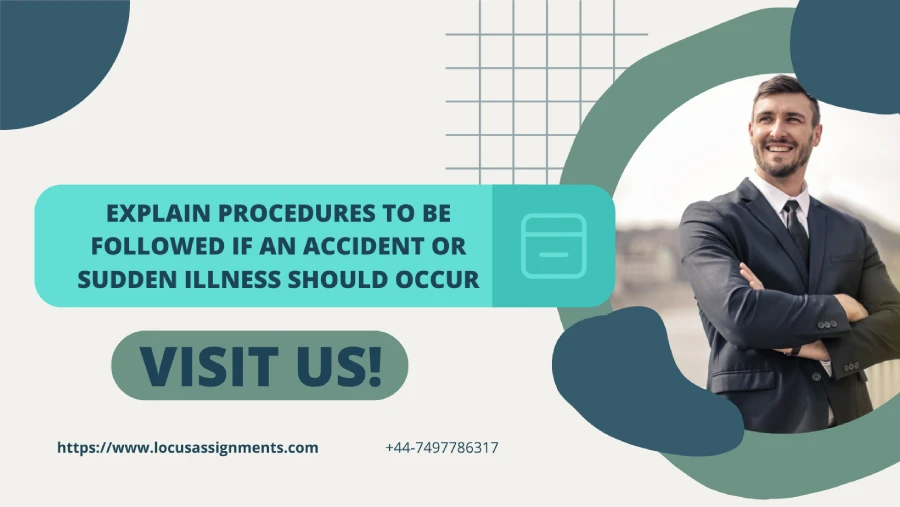Explain procedures to follow if an accident or sudden illness occurs

3.2 Explain procedures to be followed if an accident or sudden illness should occur
Course- Level 3 diploma in care (RQF)
Unit 8 – Promote Health, Safety, and Well-being in Care Settings
L.O 3 – Understand procedures for responding to accidents and sudden illness
Events or medical emergencies can happen spontaneously in a care environment, and a timely, correct response is required to protect individuals' health, safety, and welfare. When procedures are established, individuals can manage situations in a timely and consistent way, minimising harm caused, while fulfilling legal and the organisation's requirements.
1. Prioritise Safety.
You should assess the situation, albeit briefly, to determine the best course of action. The person must be made safe, as well as any others in the vicinity. For example, if someone has fallen, I would secure the area to make it safe while also making sure the person is not moved unnecessarily because I do not want to cause further injury.
2. Calling for Help.
If the event is serious or life-threatening, then one would call for help by dialling 999 (or the appropriate emergency number). Even if events seem to be less destructive, call for help from a qualified first aider or senior member of staff in your care environment.
Struggling to write detailed NVQ assignments about emergency procedures? Get expert assignment help UK to structure responses that meet professional standards.
3. Providing First Aid
Only qualified and competent staff should provide first aid. First aid may involve actions such as stopping the bleeding, placing the person in the recovery position, or providing CPR if necessary. The staff should respond within their training and ability to avoid further contributing to the person's injuries.
4. Providing Reassurance and Monitoring
During the period of waiting for medical assistance, it is important to keep the person calm and reassured. Monitoring their condition, i.e., . Their breathing, pulse, and level of consciousness will be useful to determine if any aspect requires urgent care.
5. Documenting the Incident
All accidents and incidents should be documented as soon as possible in the organisation's accident book or the incident report form. The information in the documentation should include the date, time, where and what happened, what was done, and who witnessed the incident. The documentation is important not only for health and safety compliance, but it may also be necessary for future reference.
6. Informing Relevant People
Depending on the circumstances, there may be a need for family, next of kin, or professionals (such as a GP or social worker) to know. Employers must also report some serious accidents to the Health and Safety Executive (HSE) under the RIDDOR (Reporting of Injuries, Diseases and Dangerous Occurrences Regulations).
7. Follow-Up and Review of Procedures
After the incident, the organisation may wish to review the context in which the event took placetoo determine what changes are necessary to minimise the chances of similar incidents in the future, which may involve updating risk assessment documentation, as well as possible further training of staff and improvement of equipment and/or facilities.
Conclusion
Following these procedures allows for an immediate response to an accident or sudden illness in a care setting, and the safety of both the individual and care providers is safeguarded, whilst also complying with required legislation and supporting the delivery of care that is person-centred and of high quality.
Need Assignment help?
Expert Assignment Helper in your Service indeed.
Fast • Reliable • Expert Support
Upload NowOther Assignments